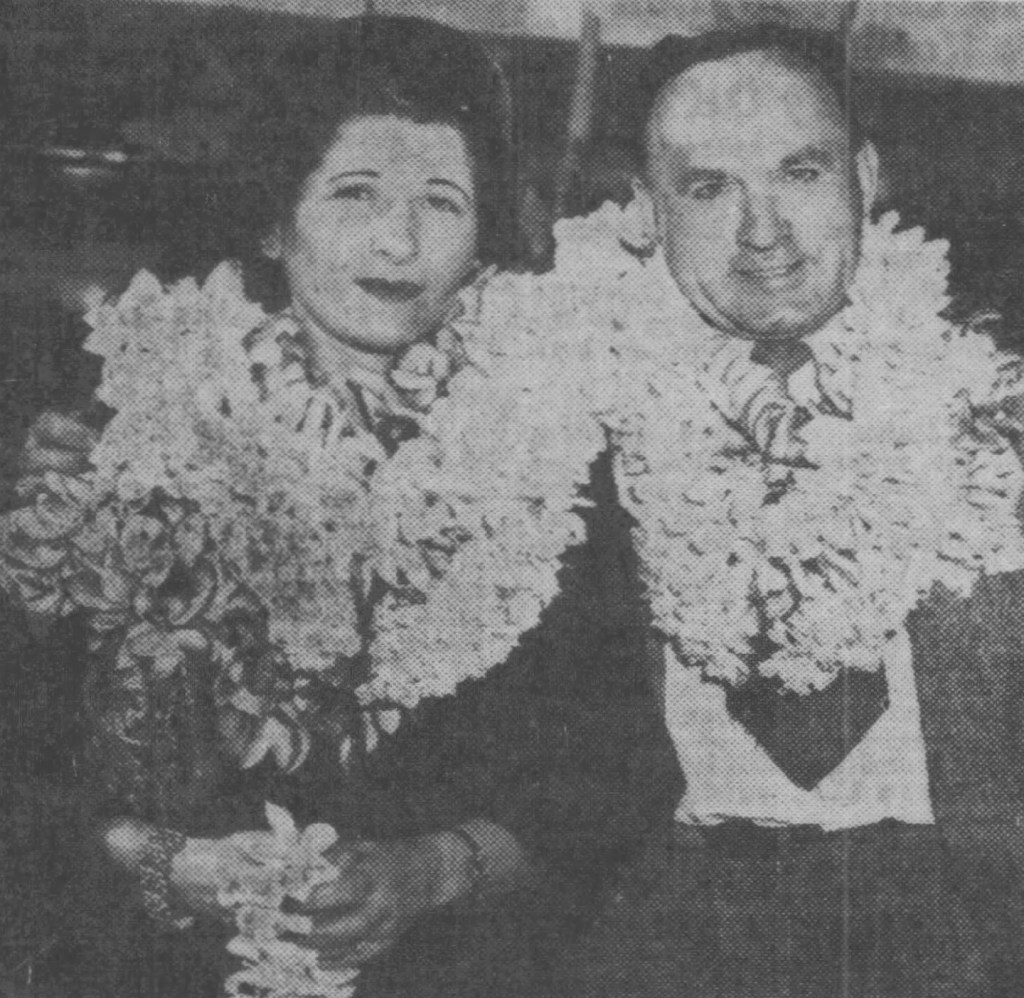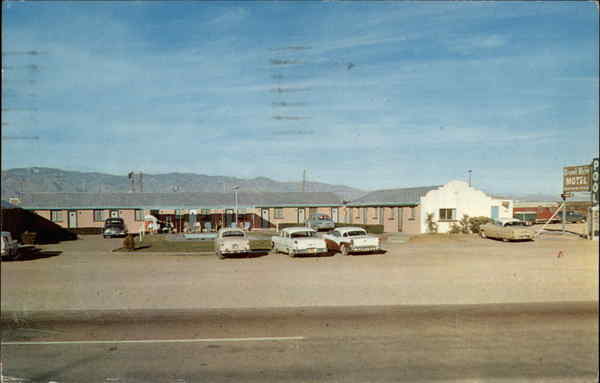
On the edge of Joseph City, Arizona, on an orphaned stretch of Route 66, stands a ruined trading post. Until last year, the remains of a sign announced that this was once Ella’s Frontier. When people speak of this place, they mention Ella Blackwell and her eccentricities, but her husband (from whom she won the trading post in a divorce settlement) is generally just referred to as a ‘bandleader’. Ray Meany was far more than that.
Born to an Irish father and Spanish mother, Ray Meany was a sailor, musician, composer, teacher, publisher, author and motel owner. Oh, so many motels! He hadn’t even reached his teenage years before he lost his father in the Great War; however, as soon as he was old enough, Ray joined the Merchant Marine and for twelve years he travelled the world. While in Hawaii he fell for a hula dancer. The romance quickly fizzled out but Ray had fallen in love with the island. On board ship, he talked constantly of Hawaii and of its music until one of his shipmates gave him a cheap guitar and bet him that he couldn’t learn to play it.

Not only did Ray learn to play that guitar, he learned to play it well. When he left the Merchant Marine, he started a steel guitar school in Oakland, California, where he introduced the lilting sound of Hawaiian music to pupils. Eventually the Honolulu Conservatory of Music of which he was the Director had some 70 branches and over 5000 pupils. In addition to the school, Ray had his own recording studio, music publishing company (which included many of his own compositions), organised large events, had his own band and produced the Music Studio News magazine. Even a brief sojourn to serve in the Second World War didn’t get in the way of his music – while serving at Camp Fannin, Texas, he continued to write a column for a national music magazine and was popular with all at the base.

After the war, his music schools went from strength to strength and Ray might indeed have built a musical empire but for a fateful meeting with a woman who changed his life. Polish-born Ella Lenkova (who had come to the USA as a small child under her original name of Aniela Lenosyk) was a musician in her own right. She would claim later that she had trained at the Julliard School of Music and there’s probably no reason to doubt that. She wrote and arranged her own songs, among them Aloha Lei, My Hula Sweetheart and Goodnight And My Aloha To You and, as Ella Maile Blackwell (Blackwell was her first married name) she was the New York correspondent for Ray’s Music Studio News. She is still mentioned under that name in a Hawaii newspaper in April 1950, but by October of that year, as she descended the steps of a Pan-Am air plane at Honolulu airport, she was Mrs Ray Meany. Interestingly, although Ray was a regular name in his local newspapers which he courted and that followed his career and achievements keenly, there was no mention of his marriage, nor of Mrs Meany.

Ray may not have known it then, but his life was about to change forever. It was still full steam ahead with his business and in 1951 he opened a new $100,000 Hawaiian music centre on Foothill Boulevard in Oakland where the building still stands. So it was a huge shock to all of his friends and pupils when he announced that he and Ella would be moving to Arizona to run a trading post. Ray explained that he felt he had a calling to help the Native Indians, saying, “I got tired of the hoopla of entertainment. I felt that there was so much I could do in Arizona among the Indians.” While Ray did indeed work hard on behalf of the locals, instigating a school and roads for the Indian tribes, the real reason was more prosaic. A jealous Ella didn’t want him mixing with the musical crowd or going off to Hawaii with his band. He would admit later in life: “Hawaiians are very affectionate people. They hug and kiss you at the slightest provocation. My wife was jealous, so I gave up the music business to keep my wife. But she didn’t like Indians either, so we separated.”

For a couple of years, Ray and Ella ran the Hopi House Trading Post at Leupps Junction on Route 66. It was several cuts above the average trading post with a motel, trailer park, café and curio shop with murals by local artists. The grand opening of the refurbished Hopi House was on 20th March 1954, but, within a couple of years, the Meanys would be divorced. They may already have owned the Joseph City trading post (then called the Last Frontier) or Ella may have purchased it with a divorce settlement, but it seems dubious that they bought it in 1947 as several books claim. It’s very unlikely that they were married then and Ray was still expanding his music career at that time.
It was at this point that Ray embarked on an almost manic buying and swapping of motels that would continue for years. It was if, adrift from his beloved music, he couldn’t find anything to give him roots. After running the Hopi House on his own, he exchanged it for a motel in California in 1957. By January 1958 he had swapped that for the Rancho del Quivari, 65 miles south west of Tucson. He was there for less than a year, selling up and buying the Copperland Motel in Miami, Arizona in November 1958. A few months later he swapped that for the Shangri-La Motel in San Diego, but by the end of December 1959 he was in the La Casita Motel in Twenty Nine Palms. He didn’t settle there either, buying the Desert Vista Motel in Benson, Arizona, where he told a local newspaper, “I think this is it. I intend to stay in Benson.”

But just weeks later, in June 1960 he had sold up and bought the Sun Set Motel in Sedona where he managed to stay for two years, moving to a motel in Texas in July 1962. There were probably others in between, but in 1969 he was in Arkansas, desperately trying to sell the Riverside Motel in Lake Greesonak. Eventually he did, but at a loss. During this time, he had kept his contacts with the music industry and every once in a while might compose another song, but the glory days were over, although one of his songs, Hula Lady, was a big hit in Japan in the early 1980s. He tried his hand at writing once more, publishing Fasting and Nutrition, Vital Health, a book of the philosophical musings of Chang, his Lhasa Apso dog (who, by now, had been dead for twenty years) and a title called Vacation Land.

But he still seems a man who was never able to settle down again. In autumn of 1975 Dr Elva S Acer offered him a job managing her Vita Del Spa in Desert Hot Springs, California. He was initially enthusiastic, even attending courses on the spa’s treatments, but by January 1976 he had taken off again. His last years were spent in various country clubs in Florida although he came back to California at the very end of his life, dying in Napa on 29th July 1987. His ex-wife had preceded him in death three years before, having never moved from the Joseph City trading post. Her headstone reads ‘Ella Meany Blackwell’; Ray Meany’s grave in St Helena Cemetery, Napa County, has no marker.


A dapper Ray Meany, returning from his time as an enlisted solder.

Great story and history! Loved it.
LikeLike
Thank you!
LikeLike
What a sadly fascinating tale, leaving the question why did Ray move so frequently after his separation from Ella? We will never know.
LikeLike
Indeed not. He seems to have gone from a man settled in Oakland and widely respected in the local and wider community (one newspaper said that Hawaiian guitar music never recovered from Ray leaving California) to a perpetual wanderer. One gets the feeling he never quite found what he was looking for…
LikeLike
Fantastic, thanks for sharing another great story.
LikeLike
Thank you! 🙂
LikeLike
No doubt tha Ray was A Man of Many Colors. Thank You, Blue for another fine Five Star story and endless research.
LikeLike
Thank you!
LikeLike
Thank you Rob. 🙂
LikeLike
what a fabulous tale, but sad in places, to have given up your one love for love and then never to rest, wow
love the phrase, about wife not liking hawainns or indians.
thankyou
LikeLike
I took steel guitar lessons from his teacher, Al Cadinha in the 1940’s.
LikeLiked by 1 person
I went to high school in Sanders Arizona with a classmate named Amelia Ortega. Her father, Armand Ortega, Sr. owned a curio shop business at the Cedar Point but prior to that he owned the Hopi House that he bought from Ray Meany in 1957. Armand was one of several Ortega brothers (including Gilbert and Willie) that owned Indian souvenir business along Highway 66 and I-40 in New Mexico and Arizona. Armand Sr. also later owned the refurbished El Rancho Hotel in Gallup.
LikeLiked by 1 person
Thank you so much for that. Mr Ortega Sr is indeed a legend himself!
LikeLike
Interesting to find this! My Uncle on my non-Hawaiian side was a ukulele player and music wrote who co-wrote with Ray Meany on Hawaiian music, Helo Dominici. I wonder if you have any stories on them working together?
LikeLike
When I was a junior in high school in Hot Springs, Arkansas, Ray Meany bought a rundown roadside store near Lake Hamilton. The place was a total dump that sold tourist trinkets, colorful rocks and other assorted junk. I think that was in the summer of 1963. I worked as a reporter for the local newspaper, “The Sentinel-Record,” and I was dispatched to interview Ray, who had sent a long, rambling, error-filled, poorly typed letter to our editor in an obvious attempt to generate publicity for his new business. Some of it (the few parts that were error-free) seemed to have been copied from earlier publications. I drove out and met him, as well as his “adopted son,” a tough-looking teenager named Butch. It was a memorable meeting. Ray showed me scrapbooks that contained sheet music of his Hawaiian songs and numerous yellowed clippings about his exploits, in which I noticed some of the copy that he had included in his letter, which ended with the ecstatic statement: “Now at last, Ray has found his Shangri-La!” He also showed me his Hawaiian guitar, which was in bad shape and looked as if it hadn’t been played in years. Ray struck me as a consummate hustler, but I couldn’t help admiring his high energy and enthusiasm. He excitedly told me of his plans to turn the trinket store into a “really high-class place.” I did write a feature story about him, and he sent me a note expressing his gratitude. I can’t recall how long he stayed in the Hot Springs area, but I don’t think it was very long. I enjoyed reading your article about this very interesting man who has remained in my memory for nearly 60 years.
LikeLiked by 1 person